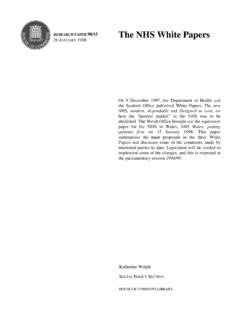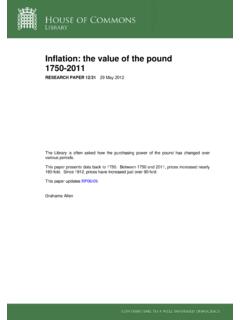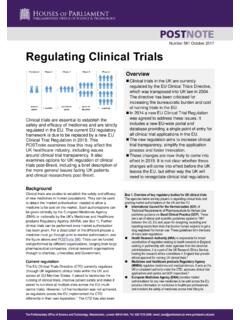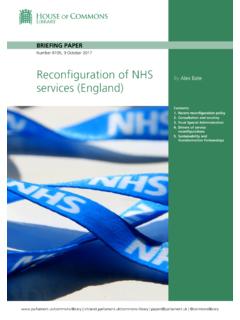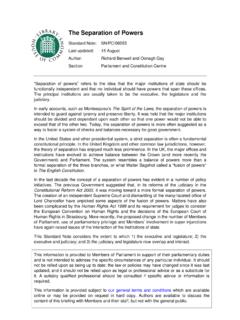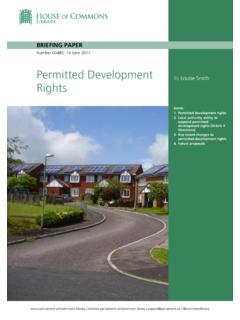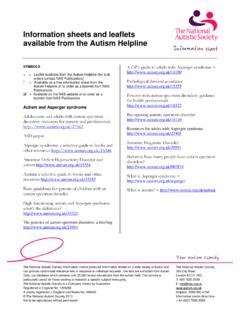Transcription of Welfare reform and disabled people
1 | | | @commonslibrary BRIEFING PAPER Number 7571, 25 April 2016 Welfare reform and disabled people By Steven Kennedy, Chris Murphy and Wendy Wilson Inside: 1. Benefits and tax credits for disabled people 2. Employment and Support Allowance 3. personal independence Payment 4. Contracted-out health and disability assessments 5. Future of Attendance Allowance 6. Universal Credit 7. Benefit Levels 8. Benefit Cap 9. Under-occupancy deduction from Housing Benefit 10. Government policy following the March 2016 Budget Number 7571, 25 April 2016 2 Contents Summary 3 1. Benefits and tax credits for disabled people 4 2. Employment and Support Allowance 6 Work Capability Assessment (WCA) 6 Time-limiting contributory ESA in the WRAG 8 Abolition of the Work Related Activity Component 8 Measures to mitigate the impact of these changes and the forthcoming White Paper 10 Conditionality and Sanctions 11 3.
2 personal independence Payment 13 Disability benefits reform 13 PIP eligibility Criteria 15 Proposed aids and appliances changes 15 Assessments and Reassessments 16 4. Contracted-out health and disability assessments 18 5. Future of Attendance Allowance 20 6. Universal Credit 21 7. Benefit Levels 23 8. Benefit Cap 25 9. Under-occupancy deduction from Housing Benefit 27 10. Government policy following the March 2016 Budget 34 Contributing Authors: Steven Kennedy, Sections 1-7, 10 Chris Murphy, Section 2 Wendy Wilson, Sections 8-9 Cover page image copyright: Wheelchair / image cropped. No attribution required 3 Welfare reform and disabled people Summary The 2010 Government embarked on a major programme of Welfare reforms, some of which will not be implemented fully for a number of years.
3 Major elements include the introduction of Universal Credit, which is replacing means-tested benefits and tax credits for working age families, and personal independence Payment (PIP), which is replacing Disability Living Allowance for people of working age. There have also been significant changes to incapacity benefits, including the continued rollout of Employment and Support Allowance (ESA), and changes to the structure of ESA and conditionality for ESA claimants. Other measures not exclusively affecting people with disabilities but which may impact on families with disabled people , include changes to benefits uprating policy and capping of the total amount of benefits the household can receive.
4 The current Government announced further Welfare measures which will affect disabled people including a four year freeze for most working-age benefits, reductions in the Benefit Cap, changes to tax credits and to Universal Credit, and abolishing the Work-Related Activity Component for new ESA claims from 2017. Following the resignation of Iain Duncan Smith as Secretary of State for Work and Pensions on 18 March, and the appointment of Stephen Crabb as his successor, the Government announced that it would not be proceeding with controversial further changes to PIP, would not be seeking alternative offsetting savings, and had no further plans to make Welfare savings beyond the savings already legislated for by Parliament.
5 Mr Crabb also said that he wanted to start a new conversation with disabled people , their representatives, healthcare professionals and employers to shape future policy and to take time to reflect on how best we support and help transform people s lives. The Library briefing provides an overview of the benefits changes introduced since 2010 affecting disabled people and their families, looks at the impact of the changes, and summarises responses from disability organisations and others. Number 7571, 25 April 2016 4 1. Benefits and tax credits for disabled people The benefits and tax credits systems provide support for disabled people and their families in various ways:1 In 2015/16, just over million adults in Great Britain received incapacity benefits (principally Employment and Support Allowance) totalling billion.
6 Extra-costs disability benefits (Disability Living allowance, personal independence Payment and Attendance Allowance) were received by million people , at a total cost of billion. 733,000 people received Carer s Allowance for caring full-time for a person receiving a qualifying disability benefit, at a total cost of billion. Further support is provided via the disability and carer premiums payable with means-tested benefits such as Housing Benefit. Other schemes include the Industrial Injuries Scheme (paying benefits totalling 905 million to 313,000 claimants); and the Armed Forces Compensation Scheme which, alongside its predecessor the War Pensions Scheme, provides support for disabled veterans.
7 In the tax credits system, additional help for disabled children is provided by the Child Tax Credit disabled child elements, and for disabled adults, the disabled worker element in Working Tax Credit. Families with disabled people are more likely to be in receipt of state benefits compared with families with no disabled people . In 2013/14, 83% of families in the UK with at least one disabled adult and no disabled children were in receipt of state support, and 38% claimed an income-related 95% of families with a disabled child (and no disabled adult) received state support, and 37% received an income-related benefit. For families with no disabled adult or disabled child, the percentages were 46% and 12% The 2010 Government embarked on a major programme of Welfare reforms, some of which will not be implemented fully for a number of Major elements include the introduction of Universal Credit, which is replacing means-tested benefits and tax credits for working age families, and personal independence Payment, which is replacing Disability Living Allowance, again for people of working age.
8 There have also been significant changes to incapacity benefits, including the continued rollout of Employment and Support Allowance (ESA), and changes to the structure of ESA and conditionality for ESA claimants. Other measures not exclusively affecting people with disabilities but which may impact on families with disabled people , include changes to benefits uprating policy and capping of the total amount of benefits the household can receive. The current Government announced further Welfare measures which will affect disabled people including a four year freeze for most working-age benefits, reductions in the 1 All figures from the DWP, Benefit Expenditure and Caseload Tables, Summer Budget 2015.
9 2 Disability defined as in the Equality Act 2010. A person is considered to have a disability of they have a long-standing illness, disability or impairment which causes substantial difficulty with day-to-day activities. 3 DWP, Family Resources Survey 2013/14, Table 4e. 4 The National Association of Welfare Rights Advisers (NAWRA) has compiled a Welfare reform Changes Chart (October 2014) which covers policy measures introduced since 2011 and future changes planned up to 2018. The chart includes details of each change and provides analysis and an assessment of the likely impact. 5 Welfare reform and disabled people Benefit Cap, changes to tax credits and to Universal Credit, and abolishing the Work-Related Activity Component for new ESA claims from 2017.
10 Number 7571, 25 April 2016 6 2. Employment and Support Allowance Employment and Support Allowance (ESA) is an income replacement benefit for people with a health condition or disability which means that they are unable to work. ESA is intended to cover day to day living costs. It can be distinguished from disability benefits such as Disability Living Allowance and personal independence Payment which help with the extra costs of disability and are payable whether in or out of work. Employment and Support Allowance replaced incapacity benefits for people making new claims from October 2008. There are two forms: contributory ESA, for those with sufficient National Insurance contributions; and income-related ESA, which is means-tested.


